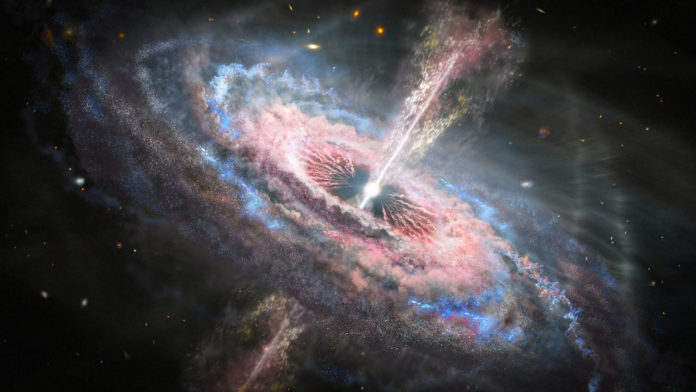Using the unique capabilities of NASA‘s Hubble Space Telescope, astronomers observed most energetic outflows ever releasing from quasars and tear across interstellar space like tsunamis, unleashing havoc on the galaxies in which the quasars live.
Principal investigator Nahum Arav of Virginia Tech in Blacksburg, Virginia, said, “No other phenomena carries more mechanical energy. Over the lifetime of 10 million years, these outflows produce a million times more energy than a gamma-ray burst. The winds are pushing hundreds of solar masses of material each year. The amount of mechanical energy that these outflows carry is up to several hundreds of times higher than the luminosity of the entire Milky Way galaxy.”
The quasar winds snowplow over the galaxy’s disk. Material that otherwise would have formed new stars is violently swept from the universe, causing star birth to cease. Radiation pushes the gas and dust to far more prominent distances than scientists recently suspected, creating a galaxy-wide event.
The outflows were observed in quasar SDSS J1042+1646. Astronomers studied 13 quasar outflows, and they were able to clock the breakneck speed of gas being quickened by the quasar wind by taking a gander at spectral fingerprints of light from the glowing gas. The Hubble ultraviolet data show that these light absorption features made from material along the path of the light were shifted in the spectrum because of the fast motion of the gas across space.
This is because of the Doppler impact, where the movement of an object compresses or stretches wavelengths of light depending upon whether it is approaching or receding from us. Only Hubble has a specific range of ultraviolet sensitivity that allows for astronomers to obtain the necessary observations leading to this discovery.
In addition to measuring the most energetic quasars ever observed, scientists discovered another outflow accelerating faster than any other. It increased from nearly 43 million miles per hour to roughly 46 million miles per hour in three years. The scientists believe its acceleration will continue to increase over time.
Team member Gerard Kriss of the Space Telescope Science Institute in Baltimore, Maryland, said, “Hubble’s ultraviolet observations allow us to follow the whole range of energy output from quasars, from cooler gas to the scorching, highly ionized gas in the more massive winds. These were previously only visible with much more difficult X-ray observations. Such powerful outflows may yield new insights into the link between the growth of a central supermassive black hole and the development of its entire host galaxy.”
Quasars are incredibly remote celestial objects, emitting enormous amounts of energy. They contain supermassive black holes which, when devours matter, hot gas encircles it and emits intense radiation, creating the quasar. Winds, driven by blistering radiation pressure from the vicinity of the black hole, push material away from the galaxy’s center. These outflows accelerate to breathtaking velocities that are a few percent of the speed of light.
When a cosmic tsunami hits interstellar material, the temperature at the shock front raises to billions of degrees. This causes elements to glow largely in X-rays as well as the light spectrum.
Arav said, “Anyone witnessing this event would see a brilliant celestial display. You’ll get lots of radiation first in X-rays and gamma rays, and afterward, it will percolate to visible and infrared light. You’d get a huge light show—like Christmas trees all over the galaxy.”
According to astronomers, such outflows can potentially explain some significant cosmological puzzles, such as why astronomers observe so few massive galaxies in the universe, and why there is a relationship between the mass of the galaxy and the mass of its central black hole.
References:
- HST/COS Observations of Quasar Outflows in the 500–1050 Å Rest Frame. I. The Most Energetic Outflows in the Universe and Other Discoveries. DOI: 10.3847/1538-4365/ab66af
- HST/COS Observations of Quasar Outflows in the 500–1050 Å Rest Frame. II. The Most Energetic Quasar Outflow Measured to Date. DOI: 10.3847/1538-4365/ab596a
- HST/COS Observations of Quasar Outflows in the 500–1050 Å Rest Frame. III. Four Similar Outflows in 2MASS J1051+1247 with Enough Energy to Be Major Contributors to AGN Feedback*. DOI: 10.3847/1538-4365/ab5967
- HST/COS Observations of Quasar Outflows in the 500–1050 Å Rest Frame. IV. The Largest Broad Absorption Line Acceleration. DOI: 10.3847/1538-4365/ab4bcb
- HST/COS Observations of Quasar Outflows in the 500–1050 Å Rest Frame. V. The richness of Physical Diagnostics and Ionization Potential-dependent Velocity Shift in PKS J0352-0711*. DOI: 10.3847/1538-4365/ab5969
- HST/COS Observations of Quasar Outflows in the 500–1050 Å Rest Frame. VI. Wide, Energetic Outflows in SDSS J0755+2306. DOI: 10.3847/1538-4365/ab5f68
